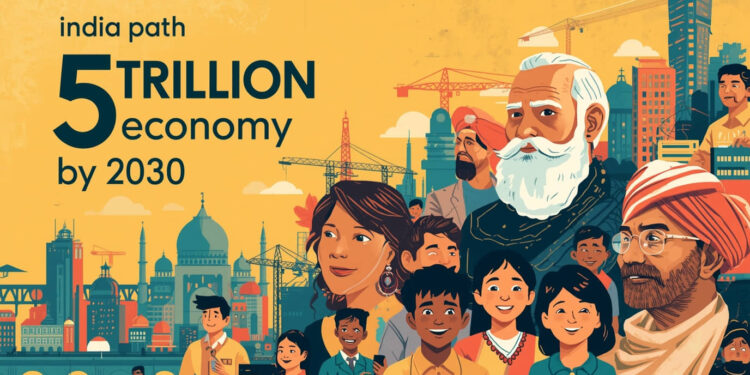India’s journey towards a $5 trillion economy by 2030 is ambitious and looks achievable. Sustained reforms plus investment plus innovation will do it. International agencies keep growth numbers high. Strong fundamentals, multifaceted policy initiatives across different sectors back them up.
Vision and Projections
India targets a place among the three largest economies of the world by 2030 with a GDP well over $5 trillion and possibly as high as $7 trillion if growth momentum stays as robust as it is now. This is due to multiple agencies’-IMF, World Bank, and several others- projections of annual GDP growth for the next few years between 6.2% and 6.6%. The optimism is being fueled by employment gains, rising domestic consumption, and increasing exports.
Pillars of Growth: Key Sectors
Manufacturing: The sector is nudged up the global value chain while getting India better plugged into supply chains through schemes like the Production Linked Incentive (PLI), “Make in India”, and MSME support.
Services: Information technology, finance, and digital economy of India are surging ahead led by the world-class level of digital public infrastructure and innovation at the frontline of competitiveness globally.
Agriculture: is shifting its focus to methods that boost income. With a splash of modern tech and related activities, productivity and rural
Structural Reforms and Policy Initiatives
Major policy reforms are driving growth:
- Goods and Services Tax (GST) has integrated the domestic markets to work as one whole, improving efficiency.
- Simplified regulatory processes plus ease of doing business reforms are attracting foreign investments into the country.
- The Digital India initiative and financial inclusion widen developmental reach and empower more entrepreneurs.
- Labor law, land acquisition, and banking sector reforms further reduce friction in the economic ecosystem.
Challenges Ahead
Despite these advances, a few hurdles remain in becoming 5 trillion economy.
- Scaling of job creation and skill development with demographic growth
- The process of urbanization is must, which is incomplete and requires huge investments in infrastructure and housing development.
- Reducing inequality and making growth inclusive is a key point to see, particularly by focusing on rural development, female labour participation, and the digital divide.
Opportunities and the Way Forward
India can accelerate its path through:
- Increasing allocations to R&D, artificial intelligence, green energy, and digital technologies͏. Advancing education, skilling, and healthcare for a robust workforce.
- Improving education system, skilling Workforce, and Increasing healthcare professionals for a strong human capital.
- Broadening physical and digital infrastructure will cut inefficiency while increasing competitiveness.
- Sustaining on clean energy, smart cities, and climate resiliency will also be a thing to achieve for the Indian government.
Conclusion
A $5 trillion economy by 2030 will be a reality if India undertakes transformational reforms and sustains growth momentum in the range of 6.5–7%. Achieving this milestone by way of steady investment, inclusive policies, innovation, and determined execution of same will also set the country on a path to becoming a high-income, resilient nation by 2047.


